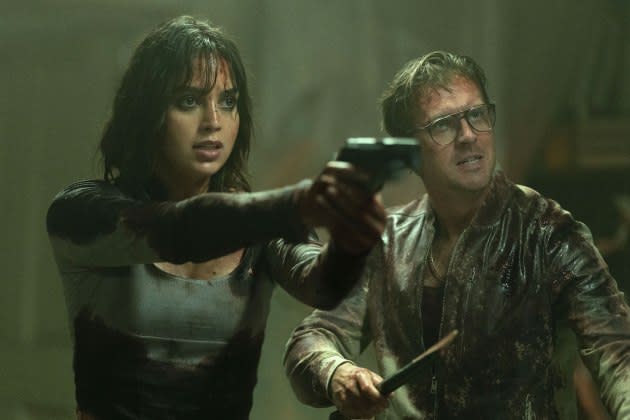‘Abigail’ Filmmakers Explain the Bloody Ending, Possible Sequel and Why the [SPOILER] Scene Was Trimmed Down

SPOILER ALERT: This story discusses major plot points, including the ending, of “Abigail,” currently playing in theaters.
The vampire thriller “Abigail” originated as a modern-day update of the classic horror film “Dracula’s Daughter.” But by the time the filmmaking trio Radio Silence — producer Chad Villella and directors Matt Bettinelli-Olpin and Tyler Gillett — began production on “Abigail” in Ireland in the spring of 2023, the movie had virtually no connection to the 1936 Universal picture.
More from Variety
“Dracula’s Daughter” follows the grown Countess Marya Zaleska (Gloria Holden) as she tries — and fails — to rid herself of her vampirism following Dracula’s death. In “Abigail,” by sharp contrast, the titular vampire is a girl, kidnapped by a team of mercenaries — led by the hot-headed Frank (Dan Stevens) and self-possessed Joey (Melissa Barrera) — under the false impression that she’s the helpless daughter of a tycoon who will pay their ransom to get her back. Eventually, Abigail (Alisha Weir) reveals that her father is Kristof Lazar, an infamous crime lord with seeming infinite resources who is far more likely to hunt down and kill the mercenaries than pay the ransom. Just when the mercs think their luck couldn’t get any worse, they discover that Abigail is actually a vampire who has tricked them into “kidnapping” her so she can kill them all for their various affronts to Lazar.
While the film leaves the implication that Lazar is a modern day moniker for Dracula, the name of the Transylvanian blood sucker is never spoken in the movie — up to and including when Lazar appears in the final scene of the film, played in an unannounced cameo by Matthew Goode.
Whether or not Lazar would even show up, however, was a subject of considerable discussion among the filmmaking team.
“It evolved significantly,” Gillett says. “So much so that I struggle to remember the finer details of what it originally was.”
One of the major points of debate was the decision to have Frank become a vampire and reveal himself to be the real antagonist of the movie, as Abigail and Joey join forces to destroy him.
“There was a point that almost everybody was the main bad guy in some version of the script,” Bettinelli-Olpin says. “It kept changing. And the Matthew Goode aspect was also a very movable piece of the puzzle. Do we want that? Do we not want that?”
Ultimately, the filmmakers decided it was important “to remind the audience this is still a crime movie,” Gillett says. “Keyser Soze still has to show up at the end and remind you there’s a bigger world at work outside of this movie.”
When asked why they cast Goode, Gillett and Bettinelli-Olpin alternate describing the actor as “imposing,” “beautiful” and “charismatic,” with a “gravitas” they knew the character needed to have the necessary impact for the ending. The actor shot on the final day of production, when the main set had already been caked in layers of blood, guts and viscera.
“He walked into this room covered in fucking blood and was like, ‘Okaaaaaay — so what am I doing?’” Bettinelli-Olpin says with a laugh. “We were like, ‘There is no ceiling. We will tell you if it’s too much. Let’s just take some swings here.’ Man, Matthew gave it a 100% for that day.”
“Melissa had kind of primed him,” Gillett says. “He had asked her, having read the script, ‘What is this fucking movie? What is the tone of this thing? What have I gotten myself into?’ And Melissa was like, ‘Don’t worry about it. Just do the weirdest, craziest thing that you can think of and they’ll love it and it’ll be great.’ And he did.”
The scene — in which Abigail successfully implores Lazar to let Joey live — originally ran much longer. “It just became a pacing issue,” Bettinelli-Olpin says. “It was all the same stuff, just more of it. And he really nailed it. But it had to get trimmed down.”
It was more important for the filmmakers to focus on the unlikely connection between Joey and Abigail, and given that both characters do ultimately survive, the movie leaves open the possibility of a sequel. But that was not the filmmakers’ intention at all.
“Audiences can sniff it out when you’re holding on to cool ideas because you maybe might get to use them later,” Gillett says.
Adds Bettinelli-Olpin: “One of the things we love about movies, period, is that they’re complete thoughts and that you can enjoy that experience at any time.”
At the world premiere for “Abigail,” Weir and Barrera both told Variety that they would be open to reprising their characters for a new film. But time is of the essence.
“Alisha is not a vampire,” Villella says of the 14-year-old actor. “She is getting older.”
Marc Malkin contributed to this story.
Best of Variety
Sign up for Variety’s Newsletter. For the latest news, follow us on Facebook, Twitter, and Instagram.